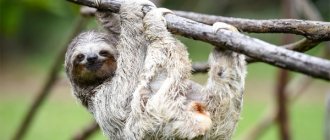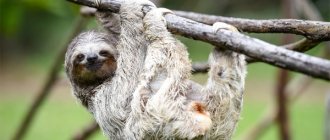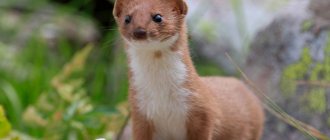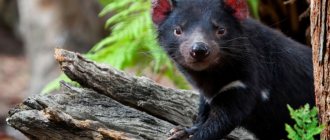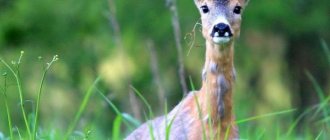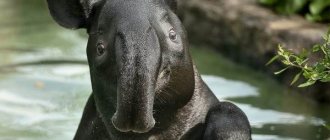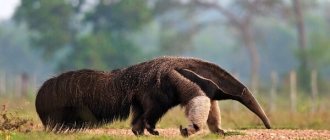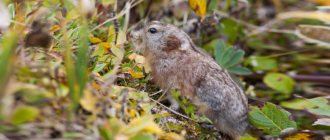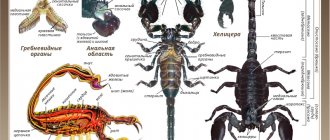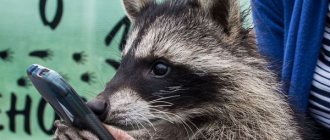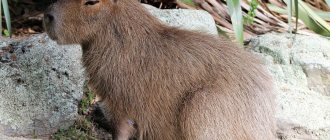Chipmunks are small, striped rodents from the squirrel family. The word “chipmunk” is translated as “household manager” or “housekeeper.” This genus of rodents includes 25 species that are common in North America, except for the Asian or Siberian chipmunk (Tamias sibiricus), a resident of Eurasia.
Description of the rodent
— Advertising —
The weight of chipmunks ranges from 30 to 120 g, body length from 5 to 15 cm, tail length from 7 to 12 cm, depending on the species. A distinctive feature of all species is the five dark stripes located along the back, which are separated by white or gray stripes. In general, the color of chipmunks is red-brown or gray-brown and is characteristic of all species, which makes it quite difficult to distinguish them.
Breeds
There are many varieties of chipmunks found in nature, but only some of them are easy to tame and keep at home. The most common are Siberian and East American breeds.
Siberian
The Siberian chipmunk is distributed in Eurasia. These animals are small in size. The length of their body rarely exceeds 15 cm, and the length of the tail - 10 cm. Stripes stand out clearly on the back. These creatures live in mixed forests, so they include more varieties of plant foods in their diet. These rodents quickly get used to people.
Eastern American
The Eastern American variety differs from its Siberian counterpart in its larger body size. Their body length reaches about 20 cm, and their tail is 12 cm. The base color of their coat is red.
What does it eat?
The basis of the chipmunks' diet is plant food, to which they occasionally add insects. In general, the composition of the feed is varied, including seeds of wild plants, buds of trees and shrubs, young branches, herbs, various berries, as well as acorns, pine and hazelnuts, and mushrooms. Near fields and vegetable gardens, chipmunks willingly feast on cereal grains, buckwheat, corn, flax, sunflowers, peas, cucumbers, plums, apricots and other crops grown by people.
For the winter, chipmunks also store a large variety of different foods: wheat, oats, buckwheat, flax, sunflowers, wild seeds, acorns, nuts, dried berries, apples, mushrooms. At the same time, the chipmunk never mixes different foods, but carefully puts them on a bed of dry grass in separate piles, or separates different foods using dry leaves. The amount of reserves in one burrow sometimes reaches 6 kg, since chipmunks are engaged in creating food reserves throughout the entire period before hibernation.
— Advertising —
The method of harvesting grain is interesting. The chipmunk climbs into a not very dense crop, selects a good ear, grabs a straw and jumps up. Because of its weight, the straw bends and the animal moves along it, holding it between its paws, and thus reaches the ear. Then he bites it off, selects the grain in a few minutes, hides it in his cheek pouches and leaves. In dense crops, where it is not possible to tilt the straw, the chipmunk bites it from below, biting off fragments and gradually reaching the ear.
What do they eat
In their natural habitat, these animals eat mainly plant foods. Their diet includes:
- flowers;
- herbs;
- berries;
- acorns;
- nuts;
- seeds;
- mushrooms;
- cereals.
In rare cases, they can eat insects and their larvae. During the spring-summer season, these animals accumulate a large layer of fat. They need it to survive the cold well.
These rodents remain active until the end of October and beginning of November. After this, they hide in their burrows and hibernate. Throughout the winter, the chipmunk wakes up only a few times to eat and defecate. To prevent heat loss, this creature curls up in a ball in its hole, hiding its sensitive nose on its abdomen. It covers its head with a fluffy tail. These animals wake up in early April.
Chipmunk distribution
Chipmunks are found throughout North America, from the Arctic Circle to central Mexico. The Eastern American chipmunk (Tamias striatus) lives in the east of the continent. 23 species of the subgenus Neotamias are distributed in the western regions. The Siberian chipmunk lives in Northern Europe to the Korean Peninsula and the northern regions of China, on the island of Hokkaido. In Central Europe, there are feral chipmunks that escape from their breeding farms.
Chipmunks prefer forested areas to live. Thus, the eastern American chipmunk lives in the deciduous forests of New England, the Siberian chipmunk in the taiga, and the little chipmunk in the subarctic coniferous forests of Canada. Some species are also found in open areas overgrown with bushes.
Popular message topics
- Ilya Muromets
Since ancient times, there have been stories and legends about Ilya Muromets, unfortunately, not all have reached us. These stories described the most incredible characters and giants, and robbers of all stripes, and even mighty wars of other nationalities. - The Great French Revolution
The bourgeois revolutions that took place in England and Holland did not leave behind such a mark as the revolution that took place in France in 1789. The French Revolution ended in 1794, - The duel and death of Alexander Sergeevich Pushkin
Alexander Sergeevich Pushkin. Today we can already say that this is perhaps one of the most authoritative writers and poets in all of Russian literature. Having lived a short life, only 37 years, he managed to leave a significant mark on history,
Kinds
Eastern chipmunk
- Latin name: Tamias striatus
- Synonyms: Eastern American chipmunk
- Body length: 14-19 cm.
- Tail length: 8-11 cm.
- Weight: 70-140 g.
The back is reddish-brown with five short white stripes, which are bordered by dark fur. The tail is reddish-brown.
The species' habitat covers the eastern United States and southeastern Canada, where the chipmunk is found in deciduous forests, bushes, and among rocks.
Asian chipmunk
- Latin name: Tamias Sibiricus
- Synonyms: Siberian chipmunk
- Body length: 12-17 cm.
- Tail length: 7-12 cm.
- Weight: 80-111 g.
- Gestation period: 28 – 35 days
- Life expectancy in nature: 3-4 years
- Lifespan in captivity: 7-10 years
The legs are short. The color is variegated. The back is grayish-brown or reddish with five longitudinal black stripes, which are separated by light ones. The belly is whitish. The tail is gray above, red below. The coat is short and rough. Molting occurs once a year, in July-September. The ears are small, without tufts. Cheek pouches are well developed.
The species is distributed in the taiga zone of Eurasia (Russia, the Far East, Northern Mongolia, Sakhalin Island and Hokkaido). The species acclimatizes well and independently spreads to new territories.
Townsend's chipmunk (Tamias townsendii)
The body length is 23-29 cm, the tail is 10-13 cm long, the body weight is from 65 to 89 g. The upper body is light or dark orange-brown, on the back there are five dark stripes, which are separated by four orange stripes. The belly and throat are white to cream colored. The top of the tail is blackish-gray or silver, the bottom of the tail is bright orange. In winter the fur is darker than in summer.
The species lives in Canada (British Columbia) and the USA (Oregon, Washington), in dense forests.
Pine chipmunk (Tamias amoenus)
The body length of the species is 19.5-23 cm, the tail length is 6.6-11 cm, the weight is 42-89 g. The fur is colored from red to pink-brown, the back is decorated with five dark, usually black stripes, which are separated by four white or gray stripes. The sides and tail below are gray-yellow. The ears are black in front, white in back. The belly and throat are white to cream in color. In winter the fur is duller than in summer.
The species is found in Canada (Alberta, British Columbia) and the USA (California, Idaho, Montana, Nevada, Oregon, Utah, Washington, Wyoming). Inhabits coniferous forests and meadows at altitudes up to 3000 meters above sea level.
Red-tailed chipmunk (Tamias ruficaudus)
Body length is 20-24 cm, tail 9-10 cm long, weight from 44 to 79 g. The upper body is orange, on the back there are five stripes from black to brown, which are separated by four gray or yellow-brown stripes . The belly is white or cream. The tail is red below.
The species' habitat includes Canada (Alberta, British Columbia) and the USA (Idaho, Montana, Washington), where it lives at an altitude of 720 to 2400 m above sea level in coniferous forests.
Lesser chipmunk (Tamias minimus)
Body length 10-13 cm, tail length 8-10 cm, weight from 35 to 53 g. The rump is grayish in color, the sides are red-brown, the abdomen is grayish-white. The tail below is reddish-yellow to brown. There are five dark and four light stripes on the back and sides, three dark and two light stripes are on the muzzle.
Found in the USA and Canada, in coniferous and deciduous forests, in the tundra.
Reproduction and lifespan
The rut in animals begins after hibernation. At this time, you can hear something like the whistle of female chipmunks. In this way they let the males know that they are ready to mate.
After mating, pregnancy begins, which lasts about a month and ends with the birth of 3-6 blind and bald babies. The growth of their fur occurs so intensively that after 14 days the little chipmunks have a real and beautiful fur coat.
After 3 weeks, their eyes open. And somewhere around day 120-150, they gradually emerge from their hiding place. Chipmunks reach sexual maturity at 11 months. Animals live for about 10 years.
Chipmunk behavior
The chipmunk is a tree dweller. He can be content with both tall trees and thickets of bird cherry, birch, and willow. It does not live only in open areas, in clean tall forests without undergrowth. Preference is given to places with windbreaks and dead wood, as well as along the banks of rivers and streams.
The chipmunk's burrow is long, up to 3 meters, and contains a nesting chamber, large storerooms for supplies and toilets. The living area is lined with dry grass and leaves. Here chipmunks breed, sleep at night and hibernate.
In the middle of winter, chipmunks sometimes wake up, eat, and then fall asleep again. The chipmunk sleeps, curled up into a ball.
In the spring, chipmunks emerge from their burrows at different times, depending on the weather. If it gets cold again, they go into their burrows, where they wait for warmer weather and eat up their reserves.
In summer, chipmunks emerge from their burrows early in the morning, before the sun rises, and search for food until the heat becomes intense. In the evening, when the heat subsides, they come to the surface again and remain until sunset. In dense shady forests they may not hide all day. In rainy weather they remain in their burrows.
Favorite food: cereals
The chipmunk loves grain and can severely damage grain crops. The extraction process is unusual: if the spikelet is not tall and there is nothing in the way nearby, the animal jumps on it, holds on with its paws and takes a bite.
If there are other ears of corn nearby, the straw below is snacked on. The chipmunk quickly puts the grain in its cheeks and runs into the hole.
Natural enemies
The main natural enemies of chipmunks are small predatory animals and birds of prey. Occasionally, they are also pursued by large predators such as a bear, which seeks to dig up a chipmunk's burrow in search of its winter food reserves.
When people or dogs approach, chipmunks make a jerky “tink” or whistle. At the same time, the animal sits on its hind legs and examines the approaching person. Having allowed him 20-30 steps, the chipmunk runs away and continues repeating the alarm signal while running to notify his relatives of the danger.
Meet the taiga chipmunk
Along with the plant world, people often come into contact with animals. A gift from nature will be the opportunity to see and observe taiga birds: capercaillie, black grouse. Of the predators, the most likely encounter is a bear, which you need to beware of.
Nevertheless, the taiga is a beautiful place and it is impossible to resist the temptation to wander through it and collect its tasty and healthy gifts.
Those who are new to the taiga will be surprised by the chipmunk. This cute little animal does not run away, minds its own business, looking at people with interest.
If you don’t make any sudden movements, and also lightly throw something tasty to him - bread, a nut, then the little fluffy creature will get very close to the “new acquaintance”.
Little cheerful balls - the decoration of the taiga - move very gracefully and are quite sociable for wild animals.
Note!
Chinchilla at home - description, color, character, features and conditions of detention. All the pros and cons of maintaining a house + reviews
Marmots - life features, interesting facts, habitat, photos, enemies, population
The gerbil is a representative of rodents, features, habitat, diet, interesting facts + photos
Interesting facts about the rodent:
- Chipmunks are bred in captivity; it is recommended to do this one at a time, so that there is no rivalry or fights between the animals. Chipmunks that grow up in captivity are easily tamed. Domestic chipmunks choose a varied diet, adding nuts and berries to their diet. The cage should be as large and spacious as possible; its bottom should be lined with a special substrate for rodents (wood bark, sawdust). To maintain physical fitness, the cage is equipped with a running wheel.
- In places where agricultural crops are located near forests, chipmunks are pests of fields. In some cases, these animals are capable of stealing the entire crop from the field.
- Chipmunks are represented in world cinema, for example, Chip and Dale, cartoon characters are chipmunks. The virtual musical group “Alvin and the Chipmunks” from the film of the same name was also loved by viewers.
Area
All species of chipmunks, with the exception of one, the Asian one, live in North America. Asian, respectively, lives in the middle zone and southeast Asia, as well as in the European part of Russia. All but one of the North American species live in the west of the continent, and one in the east. The Eastern American lives from the southern regions of Canada to the northern outskirts of Florida.
Most often, a chipmunk can be seen in a light forest, through which the clicking and chirping of the animal can be heard far away.
